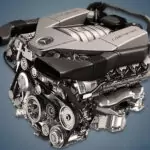The M113 E50 engine is an unusually lightweight, compact engine (unlike its predecessor M119) was a continuation of the line of three-valve M112 engines. The engineers added two more to the six cylinders and got the M113. Due to its compactness, it was installed on all rear- and all-wheel drive Mercedes models. Each cylinder has three valves (two intake and one exhaust), and in the M113 engine, the area of the exhaust valve is 30% less than the total area of the two exhaust valves in its predecessor, in addition, it has less weight (the rod is filled with sodium).
The V8-family includes: M113 E43, M113 E50, M113 E55, M119 E42, M119 E50, M119 E60, M156, M157, M177, M273, M278.
Specifications
| Production years | 1997-2008 |
| Displacement, cc | 4966 |
| Fuel system | injector |
| Power output, hp | 296 – 306 |
| Torque output, Nm | 460 |
| Cylinder block | aluminum V8 |
| Block head | aluminum 24v |
| Cylinder bore, mm | 97 |
| Piston stroke, mm | 84 |
| Compression ratio | 9.5 |
| Features | no |
| Hydraulic lifters | yes |
| Timing drive | double row chain |
| Phase regulator | no |
| Turbocharging | no |
| Recommended engine oil | 5W-40 |
| Engine oil capacity, liter | 8.0 |
| Fuel type | petrol |
| Euro standards | EURO 2/3 |
| Fuel consumption, L/100 km (for Mercedes S500 W220) — city — highway — combined |
18.9 8.9 13.2 |
| Engine lifespan, km | ~350 000 |
| Weight, kg | 196 |
Disadvantages of the M113 E50 engine
- The main problem of the power units of this family is the huge oil consumption.
- The main cause of the oil burner is usually hardened valve stem seals.
- Due to contamination of the crankcase ventilation, the lubricant presses through gaskets or seals.
- Also, the source of leaks is often the oil filter housing and heat exchanger.
- Another branded engine failure is the destruction of the crankshaft pulley.






